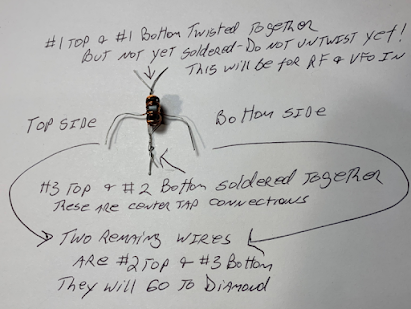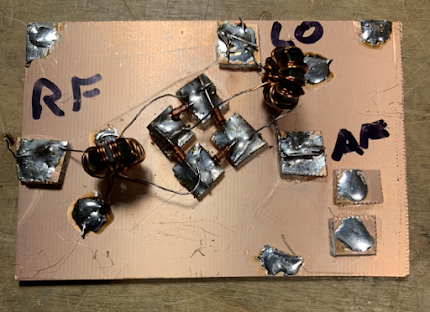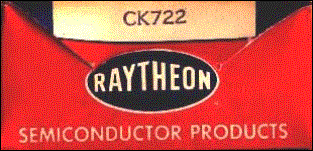We are starting to see similar efforts in different parts of the world -- Andreas with university students in Germany, Daniel with high school kids in Canada. We hope there will be others.
Serving the worldwide community of radio-electronic homebrewers. Providing blog support to the SolderSmoke podcast: http://soldersmoke.com
Podcasting since 2005! Listen to Latest SolderSmoke
Sunday, March 5, 2023
Farhan's High-School Direct Conversion Receiver Workshops in India
Saturday, March 4, 2023
Fourier Analysis Explained (video) -- Understanding Mixers
Friday, March 3, 2023
My HP8640B Signal Generator Lives Again
I'd really come to like this old signal generator. The construction is superb. It was built to be repaired. As you open it up you find all kinds of useful diagrams and pointers. It is very solidly built - it looks like something that was built for the Apollo program. And it was given to me by a friend: Steve Silverman KB3SII gave it to me in 2017 -- he had it in his New York City shack. Dave Bamford W2DAB picked it up for me just before Steve moved out of the city.
I've already done one complex repair on it -- one of the tines on one of the selection switches fell of and I had to replace the tine. That was difficult, but it was a very satisfying repair.
But lately, the HP8640B started acting up again. It developed an intermittent problem that caused both the signal generator and the frequency counter to just shut down.
I was thinking that this might be the end of the road for the HP8640B. I even started looking for alternatives. But they were all very unappealing. They come in plastic boxes with names like Feeltech and Kooletron. The boxes are filled with flaky wiring and boards hot glued to the plastic. Yuck. The contrast with the HP8640B could not be stronger.
So I started to think about the problem. This was the first part of the troubleshooting process. I asked myself: What would cause several different systems (counter, frequency generator, and display) to all shut down? The power supply was a leading candidate.
I started reading the power supply section of the HP8640B manual. There was a line in there that caught my eye: The power supply boards had on them LEDs that glowed if the board was functioning. Thank you Hewlett Packard! I opened the top of the signal generator and found the power supply boards. Sure enough, there were the LEDs. I turned the generator on, and found that one of the lights was out. Bingo. (Trevor takes a look at the power supply boards in the video above. I have it cued up to the 12:57 point at which he talks about and shows these boards.)
Here was the other clue: The problem was intermittent. It kind of seemed like a loose connection. So I just unseated the board and took it out. I put some De-Oxit on the connector and popped it back in. Boom: The LED came on and the HP8640B came pack to life.
There is a whole bunch of great info and videos on the HP8640B on the internet. It is almost as if a cult has developed. This signal generator is worthy of a cult following. Count me in.
I especially liked the video below. Kevin really captures the admiration that many of us feel toward the way this piece of gear was built. He also kind of hints at the way this sig gen could become a pirate transmitter on the FM broadcast band (at 8:44):
I know that eventually the problematic plastic gears in this device might fall apart. I am prepared for this: I already have the metal replacement gears from India.
Thanks again to Steve Silverman KB3SII and Dave Bamford W2DAB for bringing me into the HP8640B cult.
Tuesday, February 28, 2023
A Couple of New Digital Multimeters: a Fluke and an AstroAI
Our high school direct conversion project made me realize that I really need to upgrade my digital multimeter. I've been using an old Radio Shack DMM that I bought about 25 years ago. It is OK, but it is not auto-ranging and it is starting to physically deteriorate. So off I went to Bezos-land.
First I spotted the Fluke 101. I was enticed by the brand and the low price. But when it got here I was a bit disappointed. It is really small -- smaller than my cell phone. It is auto-ranging, and it does measure capacitance, but it doesn't measure hFe and the frequency counter only goes up to 100 kHz. I couldn't use it to measure the frequency of our DC receiver PTO. So, back to Bezos. (I'll keep the Fluke as a toolbox DMM.)
Next I found the AstroAI True RMS 6000 DMM. Obviously not as prestigious as the Fluke, but both the Fluke and the AstroAI are manufactured in China. The AstroAI was really inexpensive: Like 34 bucks. And Amazon would do same day delivery here. Soon it was on my front porch.
I've only been playing with it for a day or so, but I really like it. It is auto-ranging, it has automatic shut-down, the frequency counter goes up to 60 MHz, it measures hFe and even has temperature sensor. The frequency counter had no problem measuring the output frequency of our DC RX PTO. The screen is big and bright. And I think the True RMS feature will be very helpful when I try to measure amplifier gain.
I like it. And you can't really go wrong for the price. 34 dollars!
I have the Astro AI DMM in the Amazon ads on the right-hand column of the blog. I should have bought the package with the additional test probes. Click over there on the right for more info.
Sunday, February 26, 2023
First QSO with the High-School Receiver -- 100 mW to Dipole. (with videos) -- Homebrew to Homebrew!
This little contact is a reminder of the fun that can come from using simple, homebrew, QRP gear. It is really amazing that the very first contact with this receiver was with another homebrew station. This all reminds Dean and me of something we have been telling the students: the little DC receiver they are building is not a toy -- it is capable of being used in real, long-distance contacts.
Saturday, February 25, 2023
Progress Report: High-School Students Build Diode Ring Mixers (Board #2 of 4). Hyderabad Soul Added to the New Machines
A team from the Vienna Wireless Society was back in the local high school Thursday and Friday of this week, helping the students finish their variable frequency oscillators and build their diode ring mixers. Club President Dean KK4DAS was in the lead, and did an amazing job working with the school and procuring all the needed parts. Mike KD4MM and Don KM4UDX provided patient and understanding help to the students.
On the oscillators, the students had to add about six parts to install a buffer circuit built around a J310 FET. They also had to replace some of the 3D printed coil forms for the main-tuning variable inductor. (Dean KK4DAS made some really nice forms -- see below.) Several teams of students experiences were very pleased to get their oscillators running.
Then it was on to the diode ring mixer. We had planned on having the students wind their own trifilar toroids, but we realized that this might be too much -- it would add a lot of time to the build, and would introduce a lot opportunity for error.
I remembered that Farhan had given me a big supply of FT-37-43 trifilar toroids that had been assembled in Hyderabad. We decided to use these transformers. We reasoned that this was not a big deviation from our DIY ethos -- after all, we didn't ask the student to wind their audio transformers, nor did they wind the RF choke in the VFO buffer. But we faced a problem: the Hyderabad transformers were all wound with the same color wire on all three turns. This would make it hard for the students to figure out which wire went where (there were 12 such wires on each mixer board!). I figured out how to do this: The night before, I soldered together the center tap wires, and I twisted together the input coil wires. We told the students to first solder the center taps in place, then solder the two free wires to the diode ring, and finally untwist the input coil wires, soldering in these connections. This worked.
Before we started, I gave the students a quick class on the essentials of mixers. And I pointed out that we were using transformers made in Hyderabad India and donated by our friend Farhan. I told the students that whenever we include parts given to us by a ham radio friend we are adding "soul to the new machine." Indeed, Farhan's toroids added a lot of soul.
We have been insisting that the students have each stage tested before moving on to the next. This week we used signal generators to put RF and VFO energy into the mixers, and oscilloscopes to make sure that audio was coming out.
The students are making good progress. After today's session we did an estimate of where each of the projects stand at this point:
Oscillation without the buffer: 11
Oscillation with the buffer: 5
Mixer built and tested (but no diplexer yet): 5
Mixer working, diplexer built 2
Thursday, February 23, 2023
Early (1912?) Ham Station
If you zoom in you can see the crystal and the cat's whisker.
Wednesday, February 22, 2023
The Transistor at 75, and the Raytheon CK722 (Pete's First Transistor)
https://www.eejournal.com/article/the-transistor-at-75-the-first-makers-part-1/
Part 4 is especially interesting to us because of the N6QW-CK722 connection:
Raytheon: Raytheon started making vacuum tubes in 1922. During World War II, the company made magnetron tubes and radar systems. Raytheon started making germanium-based semiconductor diodes in the 1940s and, just months after BTL announced the development of the transistor in late 1947, started making its own point-contact transistors using germanium salvaged from Sylvania diodes. After attending the 1952 BTL transistor symposium and licensing the alloy junction transistor patents from GE, the company quickly started making germanium transistors including one of the most famous transistors of that generation, the CK722, which was simply a rejected commercial CK718 transistor with downgraded specs for the hobby market. (Jack Ward has created an entire museum around the Raytheon CK722 PNP transistor.) Raytheon exited the semiconductor business in 1962.
Here are all of our blog posts on the CK722:
https://soldersmoke.blogspot.com/search?q=CK722
Here is our post on Pete Juliano's CK722:
https://soldersmoke.blogspot.com/2015/03/pete-juliano-homebrwing-with.html
Is this the Origin of the Term "Ham" Radio?
Click on the image for a better view
The timing (1895) and the context (railroad telegraphy) seem about right. But other etymologies are out there. Lexicographer Steve Silverman KB3SII is on the case. What do you guys think? Are the roots of "ham" radio in railroad telegraphy?
Tuesday, February 21, 2023
Farhan's Direct Conversion Receiver
Thank God for the Wayback machine. For a moment I feared that this article about Farhan's DC-40 receiver had been lost. (Phonestack is now some Vietnamese vendor. ) But the WayBack Machine archive came through for us.
https://web.archive.org/web/20171109081542/http://www.phonestack.com/farhan/dc40.html
Farhan's receiver has been covered on this blog before, but it is especially relevant for us now that we are immersed in our own direct conversion receiver project. Farhan was working with his niece, who was a student. We are working with high school students.
I really like Farhan's blow-by-blow description of the build. There are raw emotions here: He speaks of his hatred of LM-386s, and of how he thought of using the copper clad board as a projectile. His niece wonders about the possibility of evil spirits in the receiver. The battle against AM breakthrough is very familiar. (I like the RF choke idea.) You won't find candor like this in QST or QEX.
Farhan's DC-40 project was one of the inspirations for our high school effort. In fact, when we first went to the school, I left behind a direct conversion receiver that I had built. Taped onto the bottom of the receiver was a quote from the DC-40 article and a picture of the Wizard of Hyderabad. (See above, and click on the picture for a better look).
This week we will inject some more Farhan-ismo into our receiver. The time has come to build the mixer. Like Farhan, we will go with the diode ring. Winding the transformers would be very time consuming. I remembered that on his visit, Farhan had left me a box of trifilar toroids wound by the seamstresses of Hyderabad using FT37-43 cores. We will uses these in our build. They will add a lot of soul to the new machine.

















